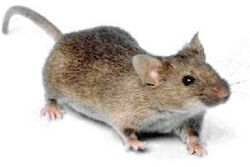Biology:Mus (genus)
| Mus Temporal range: Middle Miocene - Recent
| |
|---|---|

| |
| House mouse (Mus musculus) | |
| Scientific classification | |
| Domain: | Eukaryota |
| Kingdom: | Animalia |
| Phylum: | Chordata |
| Class: | Mammalia |
| Order: | Rodentia |
| Family: | Muridae |
| Subfamily: | Murinae |
| Tribe: | Murini Winge, 1887 |
| Genus: | Mus Clerck, 1757 |
| Type species | |
| Mus musculus[1][2] Linnaeus, 1758
| |
| Subgenera | |
The genus Mus or typical mice refers to a specific genus of muroid rodents, all typically called mice (the adjective "muroid" comes from the word "Muroidea", which is a large superfamily of rodents, including mice, rats, voles, hamsters, gerbils, and many other relatives), though the term can be used for other rodents. They are the only members of the tribe Murini.[3] However, the term mouse can also be applied to species outside of this genus.
Subgenera, species, and subspecies
The following is a list of Mus subgenera, species, and subspecies:[4]
- Coelomys
- Mus crociduroides (Sumatran shrewlike mouse)
- Mus mayori (Mayor's mouse)
- Mus pahari (Gairdner's shrewmouse)
- Mus vulcani (volcano mouse)
- Mus
- Mus booduga (Little Indian field mouse)
- Mus caroli (Ryukyu mouse)
- Mus cervicolor (Fawn-colored mouse)
- Mus cervicolor cervicolor
- Mus cervicolor popaeus
- Mus cookii (Cook's mouse)
- Mus cypriacus (Cyprus mouse)[5]
- Mus famulus (Servant mouse)
- Mus fragilicauda (sheath-tailed mouse)
- Mus lepidoides (little Burmese field mouse)
- Mus macedonicus (Macedonian mouse)
- Mus macedonicus macedonicus
- Mus macedonicus spretoides
- Mus musculus (House mouse)
- Mus musculus albula
- Mus musculus bactrianus (Southwestern Asian house mouse)
- Mus musculus brevirostris
- Mus musculus castaneus (Southeastern Asian house mouse)
- Mus musculus domesticus (Western European house mouse)
- Mus musculus gansuensis
- Mus musculus gentilulus (Pygmy house mouse)
- Mus musculus helgolandicus
- Mus musculus homourus
- Mus musculus isatissus
- Mus musculus molossinus (Japanese house mouse)
- Mus musculus musculus (Eastern European house mouse)
- Mus musculus wagneri
- Mus nitidulus (Blyth's mouse)
- Mus spicilegus (Steppe mouse)
- Mus spretus (Western wild mouse)
- Mus terricolor (Earth-colored mouse)
- Mus triton (Gray-bellied mouse)
- †Mus minotaurus (Cretan mouse) (extinct:Holocene)
- Muriculus
- Mus imberbis (Ethiopian striped mouse)[6]
- Nannomys
- Mus baoulei (Baoule's mouse)
- Mus bufo (Toad mouse)
- Mus callewaerti (Callewaert's mouse)
- Mus goundae (Gounda mouse)
- Mus haussa (Hausa mouse)
- Mus indutus (Desert pygmy mouse)
- Mus mahomet (Mahomet mouse)
- Mus mattheyi (Matthey's mouse)
- Mus minutoides (Southern African pygmy mouse)
- Mus musculoides (Temminck's mouse)
- Mus neavei (Neave's mouse)
- Mus oubanguii (Ubangui mouse)
- Mus setulosus (Peters's mouse)
- Mus setzeri (Setzer's mouse)
- Mus sorella (Thomas's pygmy mouse)
- Mus tenellus (Delicate mouse)
- Pyromys
- Mus fernandoni (Ceylon spiny mouse)
- Mus phillipsi (Phillips's mouse)
- Mus platythrix (Flat-haired mouse)
- Mus saxicola (Spiny mouse)
- Mus shortridgei (Shortridge's mouse)
Mice and human health
Mice are part of human experimentation. Many of the tests are related to new products that are launched on the market, but they are also required to try new medicines for the cure of chronic and deadly human diseases.
After the outbreak of H5N1 influenza in China in 2006, US scientists discovered that under training, mice could detect carrier birds with this virus, so they would prevent a massive contagion or threat of an epidemic.[7]
References
- ↑ Hemming, Francis, ed (1958). "Opinion 16. The Status of Prebinomial Specific Names (Published Prior to 1758) Under Art. 30d". Opinions and Declarations Rendered by the International Commission on Zoological Nomenclature 1 (B): 37. https://biodiversitylibrary.org/page/34612724.
- ↑ Oldfield, Thomas (1911). "The Mammals of the Tenth Edition of Linnæus; an Attempt to fix the Types of the Genera and the exact Bases and Localities of the Species". Proceedings of the Zoological Society of London 1911 (1): 146. doi:10.1111/j.1469-7998.1911.tb06995.x. https://biodiversitylibrary.org/page/31251974.
- ↑ Database, Mammal Diversity (2021-11-06), Mammal Diversity Database, doi:10.5281/zenodo.5651212, https://zenodo.org/record/5651212, retrieved 2021-12-01
- ↑ "Mus (mouse, genus)" (in en). Bethesda, MD: National Center for Biotechnology Information. https://www.ncbi.nlm.nih.gov/Taxonomy/Browser/wwwtax.cgi?mode=Undef&id=10088&lvl=3&srchmode=1&keep=1&unlock.
- ↑ T. Cucchi; A. Orth; J.-C. Auffray; S. Renaud; L. Fabre; J. Catalan; E. Hadjisterkotis; F. Bonhomme et al. (23 June 2006). "A new endemic species of the subgenus Mus (Rodentia, Mammalia) on the Island of Cyprus". Zootaxa (Magnolia Press) 1241 (1).
- ↑ Meheretu, Yonas; Šumbera, Radim; Bryja, Josef (2015-02-01). "Enigmatic Ethiopian endemic rodent Muriculus imberbis (Rüppell 1842) represents a separate lineage within genus Mus" (in en). Mammalia 79 (1): 15–23. doi:10.1515/mammalia-2013-0119. ISSN 1864-1547. https://www.degruyter.com/document/doi/10.1515/mammalia-2013-0119/html.
- ↑ "BioEnciclopedia - Animales que detectan enfermedades.". https://www.bioenciclopedia.com/animales-que-detectan-enfermedades/.
Wikidata ☰ Q39275 entry
 |


